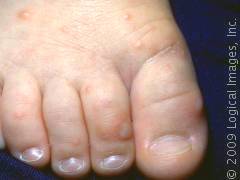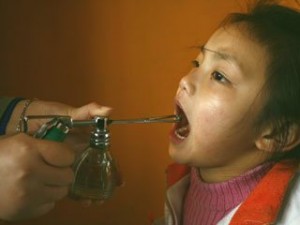Foot and mouth disease is common in children. It is a mild and contagious viral infection that is characterized by fever and sores in the oral cavity and typical rashes on the palms of the hands and soles of the feet.
The foot and mouth disease in children usually progresses within 3 days to a week.
Symptoms of foot and mouth disease in children
The foot and mouth disease usually affects the children during the fall and spring seasons, while in some climates like the tropical regions, they may be vulnerable throughout the year. Some of the symptoms of foot and mouth disease in children are as follows:
• Mild to high fever of around 100 to 102 degrees Fahrenheit and a general feeling of being unwell or malaise
• Soreness of the throat
• Red and painful patches of blisters or lesions in the mouth that affects the tongue, the inner cheeks and the gums.
• A red rash, lesions or blisters on the soles of the legs, the palms and sometimes the buttocks. The lesions of the foot may also spread to the lower calves in rare cases. The rashes may not cause itching.
• Decreased or loss of appetite. The child may not have any inclination or interesting in eating food, there is a marked loss of weight as well.
• Increased irritability in the children, especially toddlers and infants.
• The foot and mouth disease in children results in dehydration and extreme fluid loss from the body.
• Difficulty in eating and swallowing
• In rare cases, the foot and mouth disease may result in the development of encephalitis or viral meningitis
Causes of foot and mouth disease in children
Some of the causes of foot and mouth disease in children are as follows:
• Foot and mouth disease is caused due an infection by the coxsackievirus A16 belonging to the nonpolio enteroviruses group of viruses. On certain occasions, other types of enteroviruses may also cause foot and mouth disease in children
• Children are most likely to get infected with the virus through one on one contact with an infected individual, usually through oral means.
• The oral means include liquids from lesions or blisters, saliva, stool, infected droplets through a cough or sneeze, and spit, secretions from the nose or any other discharge from the throat.
• Children spend a lot of time at school, playgrounds, day care centers, etc and hence are at a greater vulnerability to get infected with the foot and mouth disease.
• Children, who have been treated for the foot and mouth disease may not show the signs or symptoms, but still tend to be carriers of the virus and may infect other children. Also, some children may be immune to the virus but can infect other children who are not immune.
Treatment of foot and mouth disease
• There is no treatment for the foot and mouth disease in children. Most of the treatment is directed at alleviating the symptoms such as, medications for fever and sore throat, oral anesthetics for the sores in the mouth and painkillers to help relieve the pain and discomfort.
• One can also try home remedies to alleviate the pain like drinking cold beverages, eating ice creams, avoiding acidic, spicy and salty food items and intake of soft foods. Children may also be assisted in rinsing their mouth with warm saline water a few times a day.
• Inculcation of good personal hygiene habits, keeping the common areas in schools, etc. clean, quarantining the infected children and washing the hands and feet after toilet use may help in preventing the foot and mouth disease in children
• If the child has fever or pain, he or she can be prescribed acetaminophen or ibuprofen. Do not given food and mouth disease suffering child aspirin. It can cause a serious syndrome called Reye Syndrome.
Prevention of Foot and Mouth Disease
• Teach all family members as well as the child to practice hygiene. If you are changing the diaper of the child, make sure you wash your hands properly with a saniter or medicated soap.
• Do not share kisses with the child or let it handle objects that will be shared.
• If you are applying ointment, cream or lotion to the blisters, make sure that you wear some kind of protection like rubber gloves or latex.
Foot and Mouth disease in Children photos

